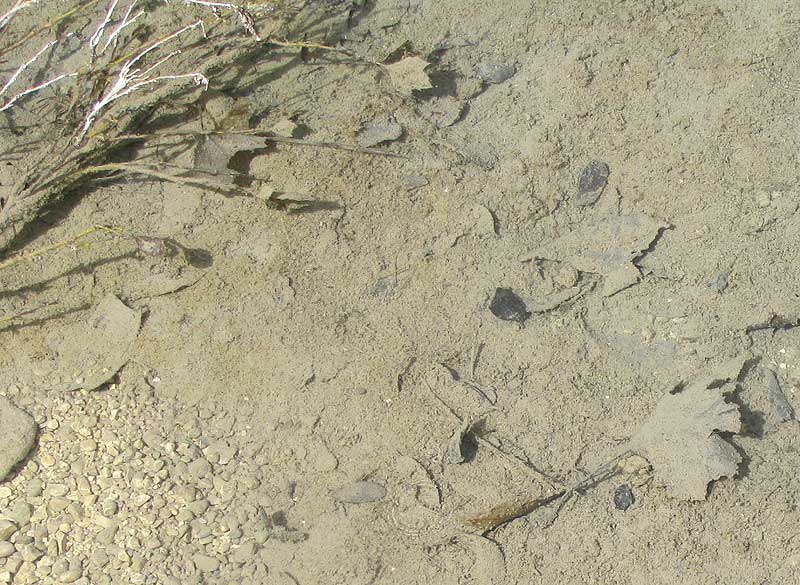Excerpts from Jim Conrad's
Naturalist Newsletter

from the July 28, 2013 Newsletter issued from the Frio Canyon Nature Education Center in the valley of the Dry Frio River in northern Uvalde County, southwestern Texas, on the southern border of the Edwards Plateau; elevation ~1750m (~5750 ft); N29.62°, W99.86°; USA
MARL
Most -- nearly all -- of the Dry Frio's submerged bed is thickly coated with marl, as you can see above, in a typical shot through ankle-deep water. Maybe you noticed the light brown, crusty material on my lower finger in the picture of a pondweed stem just removed from the Dry Frio, at https://www.backyardnature.net/n/13/130728py.jpg. That material is marl, and the pondweed's lower leaves and stems were covered with it.
An even more graphic display of brownish marl coating submerged vegetation can be seen in our picture of the network of leaves and stems of flowering bladderworts we looked at a while back at https://www.backyardnature.net/n/12/121104uu.jpg.
In that picture, mostly you see marl, not only coating all submerged parts of the bladderwort but also the rocks and mud below the bladderwort.
When water goes down, the marl dries into a gray-brown coating on all rocks and exposed vegetation, which gets washed off with subsequent rains. The presence of marl profoundly affects the Dry Frio's aquatic ecology, mainly because it's composed of stable minerals in which the elements are "locked up" -- unavailable to organisms.
My first encounter with marl was in geology class, when I learned that the mud accumulating on ocean floors -- mud rich in calcium carbonate and microscopic mineral particles -- was marl. Marl that gets buried for millions of years under high pressure eventually hardens to limestone, which is mostly calcium carbonate. When the calcium carbonate dissolves in rainwater, precipitates from the water, mingles with microscopic minerals of various kinds, and settles to the water body floor, once again it's marl.
Water holding high concentrations of calcium carbonate is somewhat alkaline. Under such chemical conditions, phosphorus in the water also is precipitated in the form of various insoluble compounds and becomes unavailable to algae and other phytoplankton. Phosphorus is one of the most important macronutrients for green plants, so the water's alkalinity in a way "starves" algae and other aquatic plants.
Because the stream floor consists mostly of constantly accumulating marl there's relatively little organic matter on the floor, which generally serves as the base of ecological pyramids. Microbes break down the organic matter, larger organisms feed on the microbes, and still larger organisms feed on those, and on up the pyramid. But, without much organic matter, there can't be much of a pyramid. In general, aquatic habitats in which marl smothers the floor are regarded as "oligotrophic" -- meaning that despite plenty of oxygen being available, a lack of plant nutrients results in a sparse growth of algae and other organisms. Oligotrophic water may be exceptionally clear and "clean-looking."
That doesn't necessarily mean that marl-bottomed bodies of water are ecological deserts. Nutrients and oxygen are present -- just that they're covered with marl. Certain aquatic plants may be able to get their roots below the marl, into a nutrient-rich environment. In this Newsletter you've seen what a robust community of pondweed has rooted in a pool with lots of marl. Maybe you also remember last December's watermilfoil, shown in very clear water in a Dry Frio pool at https://www.backyardnature.net/n/12/121021my.jpg.
Where such robust growth takes place, some stems and leaves always are dying and contributing to organic matter on the floor, which then can serve as the basis of an ecological pyramid -- if other organisms can get to it before it's smoothered in marl.
In fact, the ecology of marl-rich streams like the Dry Frio is very complex and depends on many local variables. Marl is natural and certainly has been present in the Dry Frio River ever since it began issuing from the Edwards Plateau, which is basically a big tableland of limestone composed mostly of calcium carbonate. Therefore, one can assume that the organisms in the Dry Frio over millions of years have evolved exquisite adaptations to their environment, and that the community hosts the organisms it needs most.
Still, I began wondering about the Dry Frio's marl when beneath the microscope I first examined mud and the surfaces of submerged rocks from the river, and found surprisingly little life. The microscopic organisms I've profiled from the river predominantly were found on and in aquatic plants, or free-ranging in the water, but not in the marly mud or on marl-coated rocks.